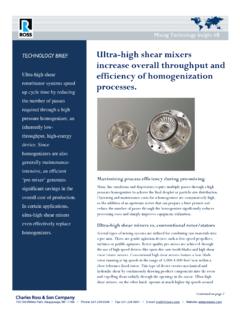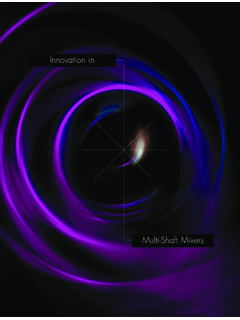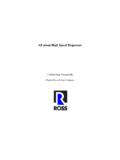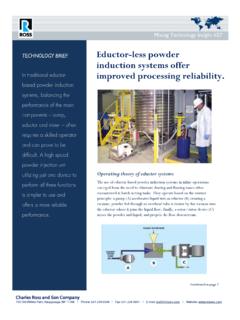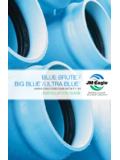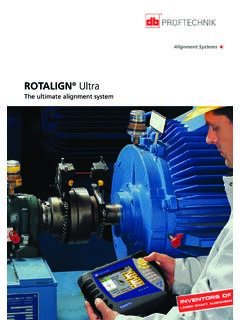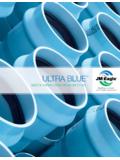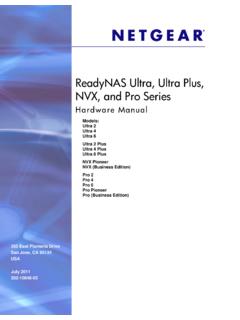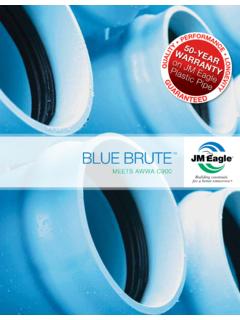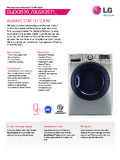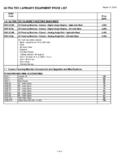Transcription of Ultra-High Shear Mixing Strategies
1 A White Paper Prepared By Charles Ross & Son Company Ultra-High Shear Mixing Strategies Ultra-High Shear Mixing Strategies Abstract This white paper presents four advanced rotor/stator technologies for Ultra-High Shear Mixing of fine dispersions, emulsions and other applications beyond the capabilities of traditional single and multi-stage rotor/stator devices. These Ultra-High Shear Mixers are shown to effectively replace costly high pressure homogenization and colloid milling operations while delivering comparable levels of dispersion and particle size reduction. Introduction Any high Shear , high speed Mixing operation whether the process goal is straightforward dispersion, particle-size reduction or emulsification generates a Gaussian distribution of results. The bottom-line objective is usually to produce the narrowest distribution possible with an equipment solution that meets both process and business needs.
2 In some applications, engineers and scientists are more concerned with average particle size while others have strict standards pertaining to the largest particles that can be present in the suspension (for example, all particles must be under 2 microns). In reality, particle size profile is just one of many indicators of a good product. Depending on the end use, other properties like conductivity, stability, viscosity, thixotropy, yield stress, color, gloss, etc., whether directly or indirectly related to particle size, are also to be considered during equipment testing and selection. The greatest extent of particle or droplet size reduction occurs within the first few passes through an inline rotor/stator mixer or the first few tank turnovers in a batch mixer set-up. This phenomenon is true for almost any dispersion or emulsion. Past this stage of sharp decrease in particle size, the distribution hovers at an equilibrium.
3 Additional processing will gradually narrow the distribution curve, but extending the process for this purpose alone almost always amounts to a substantial waste of time and energy. If the equilibrium particle or droplet size achieved in a conventional single-stage or multi-stage rotor/stator is larger than desired, manufacturers often move to higher energy devices such as high pressure homogenizers and colloid mills. The attractiveness of this solution depends heavily on the value of the product being manufactured, its competitive strength, and the overall business case for investing heavily in equipment. Aside from high capital cost, other drawbacks such as low throughput, frequent clogging, labor-intensive cleaning and high maintenance are commonly associated with high pressure homogenizers, colloid mills and similar equipment. It is therefore a welcome development that new cost-effective rotor/stator designs are capable of delivering very intense Mixing with rugged efficiency.
4 Ross White Paper: Ultra-High Shear Mixing Strategies Page 2 of 9 Ross White Paper: Ultra-High Shear Mixing Strategies Page 3 of 9 PreMax Batch Ultra-High Shear Mixer The Ross PreMax is a top-entering batch Ultra-High Shear Mixer equipped with the patented Delta rotor/stator assembly. Turning at 5,000 ft/min, the rotor is specially contoured for high pumping capacity and Shear intensity. Product is drawn from above and below the mix chamber then expelled radially through the stator slots at high velocity. The upper and lower vortexes generated in the process allow for very efficient powder additions and rapid turnover rates. Depending on the formulation, the PreMax can produce results comparable to one or two passes through a media mill. Hence, for an application that historically requires media milling, the PreMax can potentially reduce the number of mill passes or eliminate milling entirely.
5 Raw materials can then be combined and brought to the final dispersion in a single vessel. One-pot processing in the PreMax eliminates transfer steps and simplifies clean-up, dramatically cutting overall cycle time while reducing cost. Delta Rotor/Stator (US Patent No. 6,000,840). Unlike conventional batch rotor/stator mixers which are limited to viscosities under ~10,000 cP, the Delta generator of the PreMax routinely handles viscous dispersions in the range of 50,000 cP. It can also be installed in a multi-shaft Mixing system designed for processing formulations that are several hundred thousand centipoise. Ross White Paper: Ultra-High Shear Mixing Strategies Page 4 of 9 Challenging applications that involve dusty lightweight powders and/or hydrophobic solids that tend to form lumps upon contact with liquid benefit not only from Ultra-High Shear Mixing conditions but also sub-surface solids addition.
6 For improved processing of such materials, the PreMax can be equipped with the Ross Solids/ Liquid Injection Manifold (SLIM) Technology developed for sub-surface powder induction. In a SLIM set-up, a modified Delta rotor creates negative pressure powerful enough to draw solids and inject them subsurface. In other words, dry ingredients and liquids are combined at precisely the point where intense Mixing takes place. Complete wet-out and dispersion is virtually instantaneous, even with powders that would normally form tough lumps or fish eyes such as gums, fumed silica and other thickeners. Airborne and floating powders are also eliminated which contributes to faster Mixing , reduced waste, safer working conditions and easier clean-up. For example, when dispersing low bulk density pigments into liquid, the operator can dip a hose & wand attachment into the bulk bag or container and conveniently induct powders without creating a dusty environment.
7 PreMax with SLIM Induction tubing Removable SLIM plate Modified Delta rotor/stator Ball valve for modulation of solids induction Hose & Wand SLIM Attachment Air/oil hydraulic lift A Few PreMax Applications Electronic Coatings A manufacturer of electronic grade coatings was previously using media mills to produce fine carbon black dispersions. A typical cycle time for one media mill was around 12 hours, not counting the pre-mix operation. After switching to the PreMax, the same volume of finished product was finished in 35 minutes, from powder wet-out to the final fineness of grind. Paint Primers A Ross PreMax selected for Mixing paint primers reduced the overall production time from an all-day 6-8 hours to less than 1 hour in a single tank without cooling and without extensive clean-up. Below is a summary of the process changes and improvements. Old Process: Mix alkyd resins, solvents, fumed silica, clays and wetting agents using a high speed disperser for 15-30 minutes at 5,000 ft/min.
8 Pump pre-mix to a media mill. Mill for 4 hours (single pass with cooling; flowrate of 750-L/hr at 85% loading). Pump milled product to a let-down tank where it joins a stream of low-viscosity material that has been mixed in another high speed disperser for 3-4 hours. Final grind: Dv90 of <40 microns. New Process: Mix raw materials in a 300-gallon tank using the PreMax with 8 diameter rotor. Total loading and Mixing time: 38 minutes at 5,000 ft/min. No cooling required. Let down for 20 minutes. Final grind: Dv90 <18 microns. Phthalo Blue Dispersion A producer of paste colors was pre- Mixing phthalo blue pigment into an aqueous solvent using a saw-tooth disperser. The resulting pre-mix required three passes through a media mill. Realizing they needed to speed up production and increase efficiency, the company tested several options and chose the PreMax. It eliminated the disperser and produced a better quality pre-mix which then required only one media mill pass.
9 UV-Curable Coatings A manufacturer of specialty coatings used to disperse titanium dioxide powders at 40% loading into a low-viscosity epoxy resin in a tank equipped with a high speed disperser. The rough dispersion was then pumped to a ceramic bead mill and milled for four hours before being transferred to a downstream holding tank. Simulation trials on a PreMax Ultra-High Shear Mixer revealed that the milling step can be eliminated completely. Today, the UV-curable coating is batched and finished in a single tank. The Delta rotor/stator of the PreMax quickly wets out the pigment powders and, in 30 minutes, produces identical results as the previous milling process: an 8 Hegman or off the gauge dispersion. Ross White Paper: Ultra-High Shear Mixing Strategies Page 5 of 9 Ross White Paper: Ultra-High Shear Mixing Strategies Page 6 of 9 Series 700 Inline Ultra-High Shear Mixers Series 700 Mixers are inline devices available in three Ultra-High Shear rotor/stator designs namely the X-Series, QuadSlot and MegaShear (see next page for detailed descriptions of each design).
10 Running at tip speeds over 11,000 ft/min, a Series 700 mixer is capable of far greater flowrates compared to a similarly-sized high pressure homogenizer or colloid mill. It is also easier to clean and disinfect in place. Based on user experiences, the shorter cleaning time equates not only to a faster changeover procedure but also to longer intervals between cleaning cycles, longer production runs. A Series 700 mixer does not eliminate the premixing batch process the feed must be a solid dispersion or emulsion in liquid form. Like a regular single-stage or multi-stage inline rotor/stator mixer, the X-Series, QuadSlot and MegaShear behave like a centrifugal pumping device. Materials are fed by gravity or are pumped to the mixer. When an auxiliary pump is used, the inline Ultra-High Shear mixer can process viscosities up to around 200,000 cP. A comparably-sized Series 700 unit costs considerably less than a high pressure homogenizer while being less sensitive to clogging and changes in viscosity.
